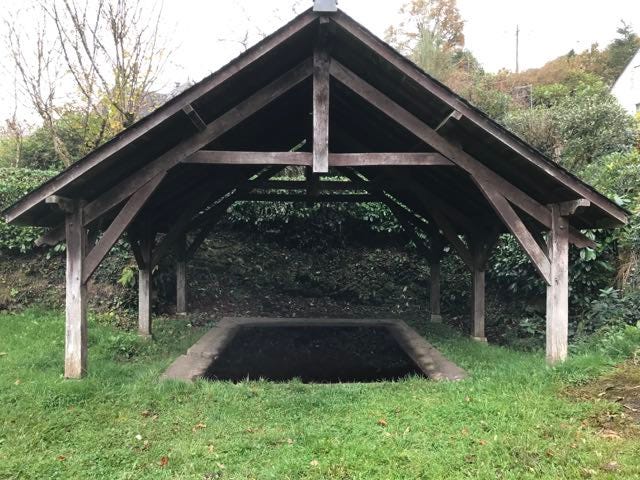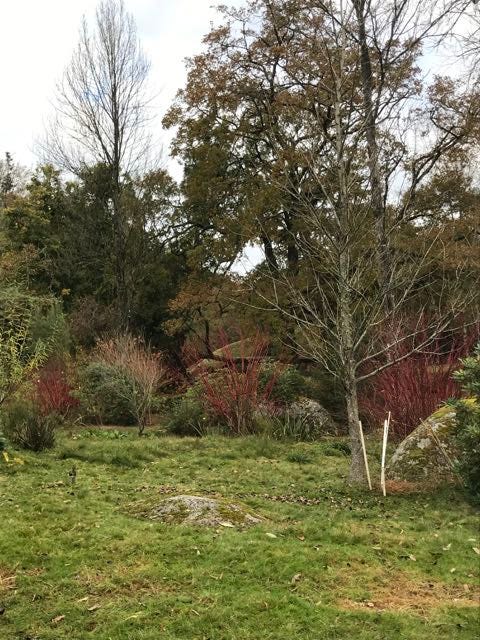If you’ve been reading this blog for a while, you’ll know that the swans on the lake in Huelgoat have acquired almost mythic status for me. (Swans are archetypal mythic birds anyway, of course.) I’ve watched for them, and watched them, with delight; I’ve held my breath when they’ve gone and been so relieved when there have been seven of them again; been very troubled when, last winter, it looked as if two of them were trapped by their feet in sheet ice (they weren’t; or if they were, they were freed when the ice melted that afternoon); and been just as troubled this year when six swans left, and one was alone all summer.
Except – when is a swan not a swan? – it turns out that the solo swan is not a swan but a goose, a white goose, and never close enough for me to spot that fact. It was tolerated by the pair of swan who came back in a few weeks ago, allowed to swim in their orbit. And – jubilation! – it’s no longer alone; and so there are two pairs now of big white birds back on the lake. I’m waiting to see if the other two pairs of swans join them.
I’ve only just found out, courtesy of my Birds of Britain and Europe book, nearly 40 years’ old now so things might have changed, that mute swans are not year-round residents here; in Finistère, they’re not even marked as winter migrants, although these birds clearly are.
Last weekend we walked round the lake, from its more domestic setting alongside the town to the wilder woody part at the eastern end. At the top end of the lake, just as a heron flew over our heads and back again, barking crossly, eleven long necks periscoped up in perfect synchrony – a family of cormorants, for the lake is full of fish, trout and carp among them. Next stop was one egret, and a family of coots.
At the other side of the lake, in a small valley full of large granite boulders and near a lavoir, all of it within the much larger megalithic site, is what is known as an ‘abri’. This literally means shelter; but what is exciting about this valley is that the abri dates from mesolithic times, older still again than most of the prehistoric sites in the immediate area.
The valley is privately owned and home to a few little black Ouessant sheep, so we can’t enter, but I suspect the abri is under that large granite boulder in the middle distance.
It’s flocking time now. Soon, the murmurations ‘proper’ will begin. Each dusk, hundreds of starlings pass over us; fieldfares too; and redwings. Although the latter spend a lot of time in our garden eating berries and carefully pecking out all the flesh of the last windfalls, neatly leaving the empty husk, I still have a shiver of delight when they come close to the house, as they do frequently, alongside the thrushes and blackbirds, inspecting the molehills and what passes for our lawn. Walking past the old orchard, you’d be forgiven for thinking that we’ve a huge aviary of budgies housed there, given all the chattering.
In England, or at least in Devon, the fields are no longer full of curlews and lapwings. The last time I saw the latter in any number was when I lived at Buckland Abbey, a National Trust property on the edge of Dartmoor near Tavistock. In those days, the late 1980s/early 1990s, I was still a shoemaker, and had a workshop in the grounds, and a flat in the old farmhouse. I remember searching the fields one early night thinking, from the high-pitched screams I’d been hearing, that a rabbit must have been snared. It took me a while to realise that the voices were that of lapwings. Yesterday I saw two separate little flocks of them, twisting black and white over the fields by the road.
In England, I still lead a poetry group from time-to-time that has been in existence for 30 years plus. As happens with poetry, or at least as happens if you are interested in the ‘soul’ aspect of poetry, the work goes very deep, and is about so much more than words. It’s an enormously significant part of my life, and it’s been a shock to me that this year, for the first time in all my adulthood, my own poetry has been elusive. Still, the trip to the Atlantic coast for TM’s birthday that I wrote about in, I think, post 35, the walk on the beach that pulled me out of a kind of depression, has had me focusing on the two very large flocks of sanderlings at the edges of the ebb tide. So, in shame really at the prolific poetry pouring out of the group the last time we ‘met’, I did squeeze out a poem. It was a hard birth, and this is first draft only, but to finish this avian post, here it is:
Tide
Light as wisps of cloud, or spindrift
it was the sanderlings that day
who brought me back:
the way they played
with waves, the way –
all foam and feather –
they dared the edges
then darted back as one,
a tide of foam and feather,
sure, nimble, fearing nothing, safe.
© Roselle Angwin
As always, my friends, thank you for joining me here. I hope you enjoyed this post.







Birds to the rescue, as ever… They’re so much a part of it all… And thank you for the most beautiful swans photo, truly stunning; and the poem too!
Yes, the sanderling poem is incredibly beautiful and I might try to translate it to Malayalam, the language of Malayalis in Kerala, India